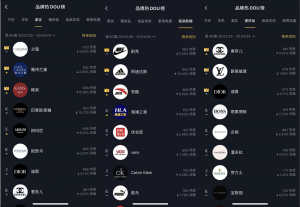As offline entertainment and retail shuddered to a halt during the COVID-19 pandemic, foreign brands traditionally successful in the Chinese market in the apparel sector, consumer tech industry, and sports brands, including the NBA, have all pivoted to Chinese short-video apps to try to maximize their reach and capitalize on the lasting behavioral shifts resulting from the crisis.
Chinese internet companies are also increasingly gravitating towards the nexus of e-commerce and livestreaming, recognizing the synergy and enormous monetization potential of content-centric shopping experience. At the forefront of this transition are China’s leading short-video apps, namely ByteDance’s Douyin, and Tencent-backed Kuaishou.
Data released in late February from Guangzhou-based iiMedia Research shows that the number of users in China’s online live streaming industry has increased 10.6% year on year to 504 million in 2019, and is expected to reach 526 million in 2020. As livestreaming becomes impossible to ignore, more platforms are integrating e-commerce features into their livestreaming capabilities.
The Chinese e-commerce livestreaming market is currently dominated by Alibaba’s Taobao Live, which boasts 800 million monthly active users, while Douyin and Kuaishou act as potent marketing tools driving users to buy products on Taobao.
In fact, Douyin links products within livestreams to Taobao, creating synergy between ByteDance’s content empire and Alibaba’s e-commerce DNA, while Kuaishou’s e-commerce platform instead links consumers to third-party vendors, as the Tencent-backed site is reluctant to channel revenue to Alibaba’s rival ecosystem.
Ultimately, Taobao, China’s leading online marketplace, has a controlling position when it comes to converting streaming to actual sales, so the essential question is, on which platform will brands choose to focus their pre-sale digital marketing strategy in China?
Douyin vs Kuaishou
When it comes to attracting international brands, Douyin has proved more successful not only because of its larger user base, which reached over 400 million daily active users (DAU) in January of 2020, but also due to the greater proportion of urban affluent users on the platform. About 24% of Douyin users come from Tier 1 cities like Beijing and Shanghai, compared to only 10% for Kuaishou, which instead has 34% of its users coming from Tier 4 cities or below, against only 22% for Douyin.
Douyin’s users are more likely to be interested in foreign brands, especially luxury items, given the relatively higher disposable income of urban users, while Kuaishou’s most popular e-commerce categories are low-price cosmetics, clothing, and food.
For Kuaishou to challenge Douyin as the go-to platform for international brands entering China, the company faces a similar challenge as to Pinduoduo’s attempts to displace incumbents Alibaba and JD.com in e-commerce, after gaining notoriety selling inexpensive items in lower-tier and rural areas.
Although upstart Kuaishou has amassed an impressive user base of 300 million DAU, the platform’s content, especially in its early days, was largely denigrated by Chinese in first-tier cities for being unsophisticated, and sometimes downright offensive, provoking a warning from regulators to control vulgar content in 2018.
This stigma surrounding Kuaishou was compounded as the app first became more popular among rural users in China’s lower-tier cities. Kuaishou’s association with lower-tier users combined with an imperfect history of bizarre or vulgar content starkly contrasts with Douyin’s aesthetic, summed up by the slogan “record beautiful life”. As a result, Douyin caters more to professionally curated content produced by key opinion leaders (KOLs), while Kuaishou offers a more authentic vibe driven by the abundance of user-generated content (UGC).
The two apps also have different methods of engaging users. Douyin relies heavily on algorithmic-recommendation content personalization. Kuaishou, instead, focuses more on community building. Specifically, Kuaishou focuses on using KOLs to bring relatable human personalities to the fore, while Douyin’s content is more centered around aesthetics and production value.
However, Kuaishou’s overall e-commerce conversion rate is significantly higher than Douyin’s, according to a Kuaishou report by Frees Fund, which could be also represented by the last Singles’ Day shopping festival, where nine of the top ten KOLs on Taobao Live were from Kuaishou, with only one from Douyin. As Douyin focuses more on its image and on premium products and international brands, Kuaishou has the potential to become the domestic e-commerce livestreaming champion as the everyman short-video app of China.
Sports
Despite the NBA’s turbulent 2019 in the Chinese market and the current suspension of the current season due to the global pandemic, the league has seen a significant uptick in online engagement on Chinese social platforms.
In addition to significant growth on Weibo over the past six months, the NBA has also tapped into Douyin, racking up 10.8 million followers since November of 2018 when the league signed a partnership with ByteDance to collaborate on content. Douyin is inherently well-suited to the tempo and style of the NBA, which features high-frequency scoring easily captured in short-video form. Kuaishou, meanwhile, lacks the clout of an NBA official account, and instead relies on UGC where creators add individual inspiration to less professional videos about basketball.
Regardless of China’s gradual economic reawakening as the COVID-19 outbreak is contained, major sports competitions including the nation’s top basketball, soccer, and volleyball leagues have been suspended indefinitely, while many other athletic events throughout the country were canceled.
In light of the ongoing crisis, London-based English Premier League club Chelsea FC took the opportunity to host a 2-hour livestream on Douyin, resulting in over 7.5 million views and stimulating Chinese fans’ digital engagement. Previously, German team Borussia Dortmund broadcasted a party for Chinese fans on Weibo in March.
With uncertainty surrounding the revival of the sports entertainment industry, digital content is more crucial than ever for international brands in China looking to leverage 5G-era latencies to increase the quality of content across short-video platforms. However, the highly curated nature of sports marketing lends itself to Douyin over Kuaishou, as ByteDances’s platform tends to offer more sophisticated video editing features and has signed strategic partnerships.

Fashion
Lifestyle sectors including fashion and beauty are increasingly leveraging the marketing potential of short-video apps to enhance their brand in the world’s largest consumer market for luxury items.
Given the relatively affluent demographics of Douyin users, premium international brands are favoring ByteDance’s Douyin over Kuaishou to focus their KOL marketing. For example, the Shanghai Fashion Week, which took place in late March of 2020, was broadcasted in its entirety on Taobao Live, and was accompanied by an official account on Douyin.
The “beauty” section of Douyin’s top charts includes international staples including L’Oreal, Lancome, Estee Lauder, Dior, and Chanel, while the”luxury items” section also contains many globally iconic brands from Louis Vuitton, Hugo Boss, and Prada, to Rolex, and Cartier.
As the COVID-19 pandemic obstructed travel plans for Chinese shoppers during Lunar New Year, a typically busy shopping period for Chinese tourists abroad, brands are boosting their digital marketing initiatives to recapture some of that absent seasonal windfall.

For example, French luxury brand Dior has used Douyin to deploy a strategy of highly curated content, amassing 440,000 followers since the account’s debut in April of 2018. The luxury firm has also brought celebrities into their Douyin strategy, including Cara Delevingne, Robert Pattinson, and Angelababy.
In stark contrast, luxury brands active on Douyin simply do not have a presence on Kuaishou, and given their target demographic, a wiser strategy for those companies is to focus on ByteDance’s domestic version of TikTok.
Apart from luxury brands, foreign sports apparel brands have also recognized the potential of short-video marketing to appeal to their customer base. Adidas, boasting 980,000 followers, was a relatively early adopter, creating its official account on Douyin in January 2018, even before Fujian-based Anta Sports which has 669,000 users. Nike, by comparison, has been late to the short-video game with only 410,000 followers after launching its Douyin account in August 2019.
Meanwhile, Nike has just over 3,000 followers on its Kuaishou official account, while Anta Sports has just under 20,000 and Adidas is absent from the platform entirely.
Smartphones
The white-hot competition in China’s mobile sector has spilled over onto ByteDance’s Douyin and Kuaishou. Although such intense domestic competition has resulted in more devices at affordable price points, smartphones are set to remain a relatively expensive category for livestreaming sales.
However, Douyin’s top charts for smartphone brands include almost all of the top players including major domestic names like Huawei, OPPO, Xiaomi, and Vivo.
Beijing-based Xiaomi has also seen the value in short-video marketing, establishing a partnership with Douyin to sell products directly through an official mini-store on the platform.

Surprisingly, major foreign phone makers such as Samsung or Apple have yet to impose a major presence. The Korean giant account on Douyin has only amassed 140,000 followers since its creation in October 2017, while Apple is notably absent from the platform entirely.

Kuaishou leverages its cast of KOLs to not only market smartphones, but convert their content into actual sales as well. For example, in November 2019, Chen Weijie, 30, an online celebrity based in Meizhou village in Guangdong province, sold RMB 160 million (USD 22.6 million) worth of products on Kuaishou, including 10,000 Xiaomi smartphones.
When it comes to official accounts, Kuaishou struggles to attract a major sales volume. Huge names in the Chinese smartphone sector like Huawei and Oppo have just over 8,000 and 2,000 followers respectively in the platform. However, Xiaomi has gained serious traction on Kuaishou, as its official account has 336,000 followers. This could be partly driven by Xiaomi’s affordable price point, appealing to less-affluent users in lower-tier cities.
Going Forward
The battle for short-video supremacy between ByteDance’s Douyin and Tencent invested Kuaishou may result in the fragmentation of the market along demographic lines, with Douyin likely to retain China’s more affluent urban areas as Kuaishou continues to grow mostly in Tier 2 cities and below.
While buyers of expensive luxury items, fans of international sports events, and smartphones’ lovers are likely to continue to flock to Douyin, Kuaishou could continue to attract customers attracted to local brands. Also, companies should be wary of dismissing China’s lower-tier consumers, as they are now the driving force behind the country’s consumption, according to a report by tech retailer Suning.
The Consumption Upgrade report by Suning found that residents in Tier 2 and Tier 4 cities “have unleashed greater consumption energy than those in Tier 1 and Tier 2 cities.” Another study by McKinsey identified that digital natives living in tier 2, 3, or 4 cities in China, were responsible for 60% of the consumption growth through 2017 and 2018, despite only being 25% of the population.
While Douyin may have the bells and whistles that premium brands and products crave, to tap into the next generation of the Chinese consumers, Kuaishou’s reach in lower-tier cities gives the platform a unique advantage.

